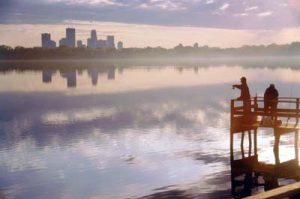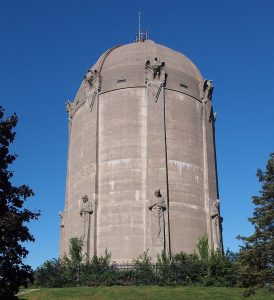
I lie down this past week and can’t sleep. Not from visions of little coronaviruses dancing, (well, mostly not, anyway): Minneapolis is burning. As the protests over George Floyd’s murder spread across the country, as politicians and society argue over what it all means, as people from outside of the Twin Cities may or may not be trying to co-opt true calls for justice, I can’t stop thinking about the Minneapolis I grew up in–the Minneapolis that I love.
My childhood home stands a mere five miles from the 3rd Precinct building that was burned last week. A year ago during a return visit, I drove through the same neighborhood: the drive filled with the warm ache of memory at the very street signs that seemed to scream Minneapolis to me. And the central location for much of the last week’s activity–Lake Street–is one I know well: I frequently drove down Lake Street while commuting to a substitute teacher job at Minnehaha Academy, the shop-lined urban streets slowly giving way to rows of houses and spreading trees and then a bluff, overlooking the blue and brown swaths of the Missisissippi.
There are a lot of Lake Streets across the country, but it’s particularly appropriate in a metropolis nicknamed The City of Lakes (there are 22 within the city limits). In the hot, humid days of summer, we would bike west to Lake Harriet or Bde Maka Ska (recently renamed from Lake Calhoun, its former moniker inexplicably taken from a notorious States Rights and pro-slavery senator from South Carolina in the early 1800s). I didn’t know then how lucky I was to be within biking distance of a lake with a public beach. I live near nothing like that now, and it’s not lying to say I miss it with the sharp pang of loss. And nothing against rivers, but there’s something about the expanse of a lake that holds the mind more peacefully.
 Of course, there are incongruities to memory. Things excised, things brought forward–the mind and desire altering things in ways you don’t realize until reality presents the contrast to you with crystal clarity. During that return visit to south Minneapolis, the Washburn Park Water Tower was just as awe-inspiring as I remembered it to be (how many stone water towers have you seen whose curved bases are flanked by warrior statues?), but the hillside on my old block just wasn’t as steep as I remember it being. A long and gentle decline in actuality, my grade-school memories have equated walking or biking up that thing to Everest.
Of course, there are incongruities to memory. Things excised, things brought forward–the mind and desire altering things in ways you don’t realize until reality presents the contrast to you with crystal clarity. During that return visit to south Minneapolis, the Washburn Park Water Tower was just as awe-inspiring as I remembered it to be (how many stone water towers have you seen whose curved bases are flanked by warrior statues?), but the hillside on my old block just wasn’t as steep as I remember it being. A long and gentle decline in actuality, my grade-school memories have equated walking or biking up that thing to Everest.
And then comes this past week, which has me remembering again how my family would generally bike west or southeast for family outings. We’d go north to visit my dad’s work in the downtown area, but there were areas we skipped between there and where we lived, taking Interstate 35W more often than not. I remember always having the feeling that the farther north we went on the residential streets, the more dangerous things got.
Where did I even get this feeling? It was more than the normal fear of leaving familiar surroundings. Was it family? The chatter of kids on the playground and on the bus? It’s one of those social and cultural things we just absorb without realizing it. I’m quite certain I did absorb it, too. A few years back, when my wife and I revealed we had driven down Lake Street on the way to the Mississippi, words were said to the effect of “Oh, isn’t that a little rough?”–an attitude and meaning coded to say it maybe should have been avoided, coding I had seen and heard before for lower income or more diverse areas.
Against the backdrop of my Minneapolis memories are a record needle scratch of hard realities and statistics. Whites are generally happy and healthy in Minnesota, but minorities are much less likely to be in the same boat (education rates follow similar trends). And in Minneapolis, police fatalities flip its racial demographics: in the past 20 years, Blacks make up about 20 percent of the population, yet they account for roughly 60 percent of police fatalities (whites are 60 percent of the population but only account for about 20 percent of fatalities).
So which is Minneapolis? The beautiful memory of my childhood? The burning city raging at its differences and inequities? (The dream or the nightmare, as Ibram X. Kendi stated in a similarly tracked article I was surprised to discover as I wrote this particular paragraph in this particular essay?)
For me–and I may be wrong–both exist. The beauty of Minneapolis is still there this week, in its places and in its people: from the shores of Lake Harriet and Bde Maka Ska to its residents coming together to help their community. And the darkness is still there, from its police terrifying residents off of their porches to “maintain order” to a semi loaded with flammable materials almost plowing down dozens of protestors on Interstate 35W (on the same site of a tragic bridge collapse nearly twelve years ago). Acknowledging the blissful side and not the other leads to a dysmorphic view, as unhealthy as one of those photoshop disasters where people try to make themselves look more attractive and end up with something completely alien. But is it foolish to hope we can change? That we can lessen the nightmare Kendi describes in his article?
We’re too far from any utopia to think it’s closely in reach… and part of our problem has been pretending we do live in a kind of near utopia. The fault lines this belief has created have kept far too many of us up late at night this past week–while lulling some others to sleep with judgmental thoughts for those protesting.
I cannot and should not go back to the security blanket of nostalgia and privilege, to the gentle hum of hammocks in tree-lined backyards and neighborhood games of kick-the-can: yet I can use those images to motivate me, to help me continue to notice the unevenness of the country I live in… and to act in ways that help bring the nightmare closer to the end. For everyone.

